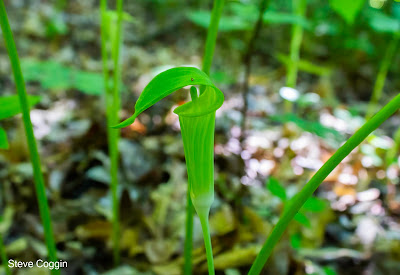 |
| Jack-in-the-Pulpit (Arisaema triphyllum) in flower. Rowan County, North Carolina. |
Preacher Jack stands in his green chapel, sermonizing in spring and in fall is transformed.
Jack-in-the Pulpit (Arisaema
triphyullum) is a perennial spring wildflower that grows in eastern North
America. Arisaema triphyllum is in the Araceae, the Arum family. This family has many well know plants including
the New World rainforest/houseplant Philodendron
hederaceum. Titan Arum (Amorphophallus titanum) is another plant in this family. It grows in Sumatra and produces the largest flower in the world. Titan Arum is also called the corpse plant because it
releases the odor of rotting flesh to attract its pollinators. Skunk Cabbage (Symplocarpus foetidus), another Araceae, grows in North American
and as its name suggest also produces a strong smell to attract pollinating insects.
 |
| Jack-in-the-Pulpit with flower and trifoliate leaves. Rowan County, North Carolina. |
Jack-in-the-Pulpit has three-part, compound leaves and in
North Carolina flowers in March and April.
And oh, what a flower Jack makes.
This complicated flower consists of a spathe (the pulpit) which is a
sheath that wraps around and makes a hood over the spadix. The spadix (Jack) is a cylinder in the center
of the spathe and contains hundreds of tiny, separate male and female flowers. The spadix produces an odor that smells like
fungus to attract the pollinators, fungus gnats. The gnats follow the smell into the spathe where
they collect pollen to take to the next flower.
 |
| Jack-in-the-Pulpit flower with spathe and spadix. Rowan County, North Carolina. |
Most of the Jack-in-the-Pulpit that grows in our area make a yellow-green spathe and spadix. There are more colorful ones out there with maroon stripes on the spathe and a purple spadix.
 |
| Jack-in-the-Pulpit in October with its bright red fruit. Rowan County, North Carolina. |
After pollination, the fertilized female flowers in the spadix develop into fruits. By fall, Jack-in-the-Pulpit bears red berries. These fruits are eaten by birds and small mammals who disperse the seeds in their droppings.
Jack-in-the-Pulpit is a long-lived plant with some specimens
surviving for over 20 years. They grow in rich woods and floodplain forests.
Jack-in-the-Pulpits are protected from herbivores because they contain
the toxin calcium oxalate. Calcium oxalate
crystals are pointed and cause abrasions when eaten and the chemical itself induces
a burning sensation.
 |
| Jack-in-the-Pulpit flower. Rowan County, North Carolina. |
Jack-in-the-Pulpit will emerge soon, preaching his sermon in the
woods.
No comments:
Post a Comment